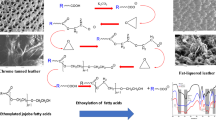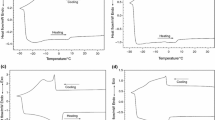Abstract
Overused vegetable oils, which are considered to be a waste and available in huge quantities after frying processes, were directly ethoxylated using a conventional cheap catalyst in order to obtain an economically valuable ethoxylated product to replace the imported intermediate derivatives and at the same time the environment will be rid of one of its pollutants. Therefore, this work was devoted to exploring its application as a fatliquoring agent in the leather industry. Overused sunflower and olein oils were directly ethoxylated using ethylene oxide gas in the presence of 3% KOH catalyst at 180 °C for 20 h. The prepared products were applied as nonionic fatliquors. The fatliquoring process is the operation in which a fatty matter is introduced into the leather fibers. The results obtained showed that the prepared ethoxylated overused oils were effective fatliquors with high HLB values giving stable oil in water emulsion as well as high stability against acid, alkali and different metallic salts. The fatliquored leather had improved mechanical properties such as tensile strength and elongation at break. In addition, a significant enhancement of the texture of the treated leather by the two prepared fatliquors as indicated from the scanning electron microscope images was observed. Also the results indicated that ethoxylated overused sunflower oil gave better results than those of ethoxylated overused olein oil.







Similar content being viewed by others
References
Cox MF (1994) Ethylene oxide-derived surfactants. In: Arno Cahn(ed) Proceedings of the 3rd world conference on detergents: global perspectives, pp 141–146
Schwartz AM, Perry JW (1949) Surface active agents their chemistry and technology. Interscience publishers, New York
Shin HS (2001) Manufacturing method of leather fat liquor by esterification and oxidation of fatty acid and monomer. Repub. Korean Kongkae Taeho Kongbo KR 2001 94,667 (Cl. D06N3/00), November 2001
Samsonova AM, Khlystova LG, Zurabyan KM (1993) Use of ethoxylated fats for fatliquoring of various types of leather. Kozh Obuvn Prom-st 8:20–21
Makdisi RichardS (1991) Tannery wastes definition, risk assessment and clean up options, Berkeley, California. J Hazard Mater 29:79–96
Alexander K, Donahue V (1990) Cleaner technologies in the tanning industry. EPA environmental challenge of the 1990s. International conference on pollution prevention: clean technologies and clean products pp 19–31, 10–13 June
Burgess D (1993) General aspects of fatliquoring: an introduction to the application and chemistry of fat liquoring. J Soc Leather Technol Chem 78:39–43
Heidemann E (1993) Fundamentals of leather manufacturing, Chap 15. In: Eduard Roether KG (ed), Darmstadt, ISBN: 3-7929-0206-0
Alexander KTW, Convington AD, Stosic RG (1993) The production of soft leather. Part 2. Drying and stress softening. J Am Leather Chem Assoc 88:254–269
Ludde FE, Barvord RA, Reimenschnider RW (1960) Direct conversion of lipid components to their fatty acid methyl esters. J Am Oil Chem Soc 73:447–451
Wrigley AN, Smith FD, Stirton AJ (1957) Synthetic detergents from animal fats. VIII. The ethenoxylation of fatty acids and alcohols. J Am Oil Chem Soc 34:39–43
AOCS (1996) Official Method Cd 3d-63, Cc 18-80 and Tl la-64. Official methods and recommended practices of the American Oil Chemists’ Society, AOCS, Champaign
Fujimoto T (1985) New introduction to surface active agents. Part 3. Chapter 3. Sanyo Chemical Industries Ltd., Japan, pp 187–218
Harris JC (1946) ASTM, Bulletin
Stevenson WTK, Sefton MV (1988) The equilibrium water content of some thermoplastic hydroxyalkyl methacrylate polymers. J Appl Polym Sci 36(7):1541–1553
Cox MF, Weerasooriya U (1997) Methyl ester ethoxylates. J Am Oil Chem Soc 74(7):847–859
Hama I, Okamoto T, Nakamura T (1995) Preparation and properties of ethoxylated fatty methyl ester nonionics. J Am Oil Chem Soc 72:781–784
Guillen MD, Cabo N (1997) Infrared spectroscopy in the study of edible oils and fats. J Sci Food Agric 75:1–11
Che Man YB, Setiowaty G (1999) Multivariate calibration of Fourier transform infrared spectra in determining iodine value of palm oil products. Food Chem 67:193–198
Fiveash Data Management (1997) FDM FTIR spectra library of surfactants
Ovalles C, Bolivar R, Cotte E, Aular W, Carrasquel J, Lujano E (2001) Novel ethoxylated surfactants from low-value refinery feed stocks Fuel 80:575–582
Griffin MC (1965) Emulsions in: encyclopedia of chemical technology, vol 8. Interscience publishers, New York pp 117–154
Akoh CC, Nwosu CV (1992) Emulsification properties of polyesters and sucrose ester blends II: alkyl glycoside polyesters. J Am Oil Chem Soc 69(1):14–19
Puntener A (1996) The influence of fatliquors on the light fastness of dyed leather. J Am Leather Chem Assoc 91(5):126–135
Egyptian Standard Specifications (1986) Physical methods of leather, E.S 123
Selvarangan R, Vijayalakshmi K, Raghunatha RAOD (1975) Leather Sci 22:265–276
Author information
Authors and Affiliations
Corresponding author
About this article
Cite this article
Nashy, ES.H.A., Abo-ELwafa, G.A. Highly Stable Nonionic Fatliquors Based on Ethoxylated Overused Vegetable Oils. J Am Oil Chem Soc 88, 1611–1620 (2011). https://doi.org/10.1007/s11746-011-1809-9
Received:
Revised:
Accepted:
Published:
Issue Date:
DOI: https://doi.org/10.1007/s11746-011-1809-9




